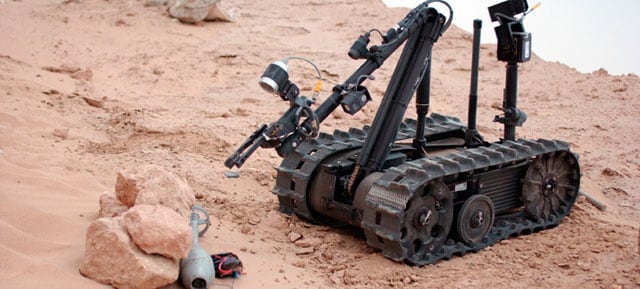Following the draft circulation last October, the Army has finalized and released a report on robotics and their applicability within Army strategy and doctrine.
The Army's "Robotic and Autonomous Systems Strategy," or RAS, released by the Army's Training and Doctrine Command this week, details how the Army will incorporate emerging technologies into its force structure and the benefits these advancements provide.
The strategy outlines three primary goals:
- An intellectual framework necessary to unify various RAS efforts and initiatives taking place within the Army
- Give direction for future allocation of resources
- Identify near-mature technologies that can benefit the future Army.
Moreover, the document provides five capability objectives to guide technology development:
- Increase situational awareness
- Lighten the war fighters’ physical and cognitive workloads
- Sustain the force with improved distribution, throughput and efficiency
- Facilitate movement and maneuver
- Protect the force
"Effective integration of RAS improves U.S. forces’ ability to maintain overmatch and renders an enemy unable to respond effectively," the strategy asserts. "The Army must pursue RAS capabilities with urgency because adversaries are developing and employing a broad range of advanced RAS technologies as well as employing new tactics to disrupt U.S. military strengths and exploit perceived weaknesses. RAS are increasingly important to ensuring freedom of maneuver and mission accomplishment with the least possible risk to Soldiers."
The strategy identifies three technology advancements that over the next 25 years will be essential to allow the "fastest, and cost effective achievement of the RAS capability objectives": autonomy, artificial intelligence and common control, described as the ability for one common software package to control a multitude of ground and air systems.
This effort by the Army follows similar joint and service-specific efforts aimed at embracing technological advancements and harnessing the nature of modern warfare that traverses domains of war, described in Army parlance as multi-domain battle.
"Consistent with the 2015 National Military Strategy, the RAS Strategy describes how the Army will use human-machine collaboration to meet the [Joint Chief of Staff] Chairman’s goal of increasing operational options for Joint Force commanders," Gen. Daniel Allyn, Vice Chief of Staff of the Army, wrote in the forward of the strategy. "The integration of RAS will help future Army forces, operating as part of Joint teams, to defeat enemy organizations, control terrain, secure populations, and consolidate gains. RAS capabilities will also allow future Army forces to conduct operations consistent with the concept of multi-domain battle, projecting power outward from land into maritime, space, and cyberspace domains to preserve Joint Force freedom of movement and action."
The RAS provides metrics measured in near-term (2017-2020), mid-term (2021-2030) and far-term (2031-2040) for achieving the objectives it sets out detailing short operational vignettes for how they’ll be employed.
With near-term priorities ranging from increasing situational awareness for dismounted forces at lower echelons, protecting forces with explosive ordinance disposal robots and lightening physical loads for dismounted forces, the Army hopes to get at far-term priorities 20 years in the future. Those will include increased situational awareness with persistent reconnaissance from swarming systems, improving sustainment with autonomous aerial cargo delivery and facilitating maneuver with advancements to unmanned combat vehicles.
"Over the last few years, commercial and military research efforts have made great advances in air and ground autonomous technology," said Maj. Gen. Robert "Bo" Dyess, acting director, of the Army Capabilities Integration Center, which spearheaded the development of the strategy. "We must invest to take advantage of these developments to benefit the future force. Now is the time to increase situational awareness at lower echelons with commercially-available aerial drone technology, to roboticize combat vehicles performing dangerous tasks, and to invest in the technical development of future systems with semi-autonomous capabilities."
Mark Pomerleau is a reporter for C4ISRNET, covering information warfare and cyberspace.






